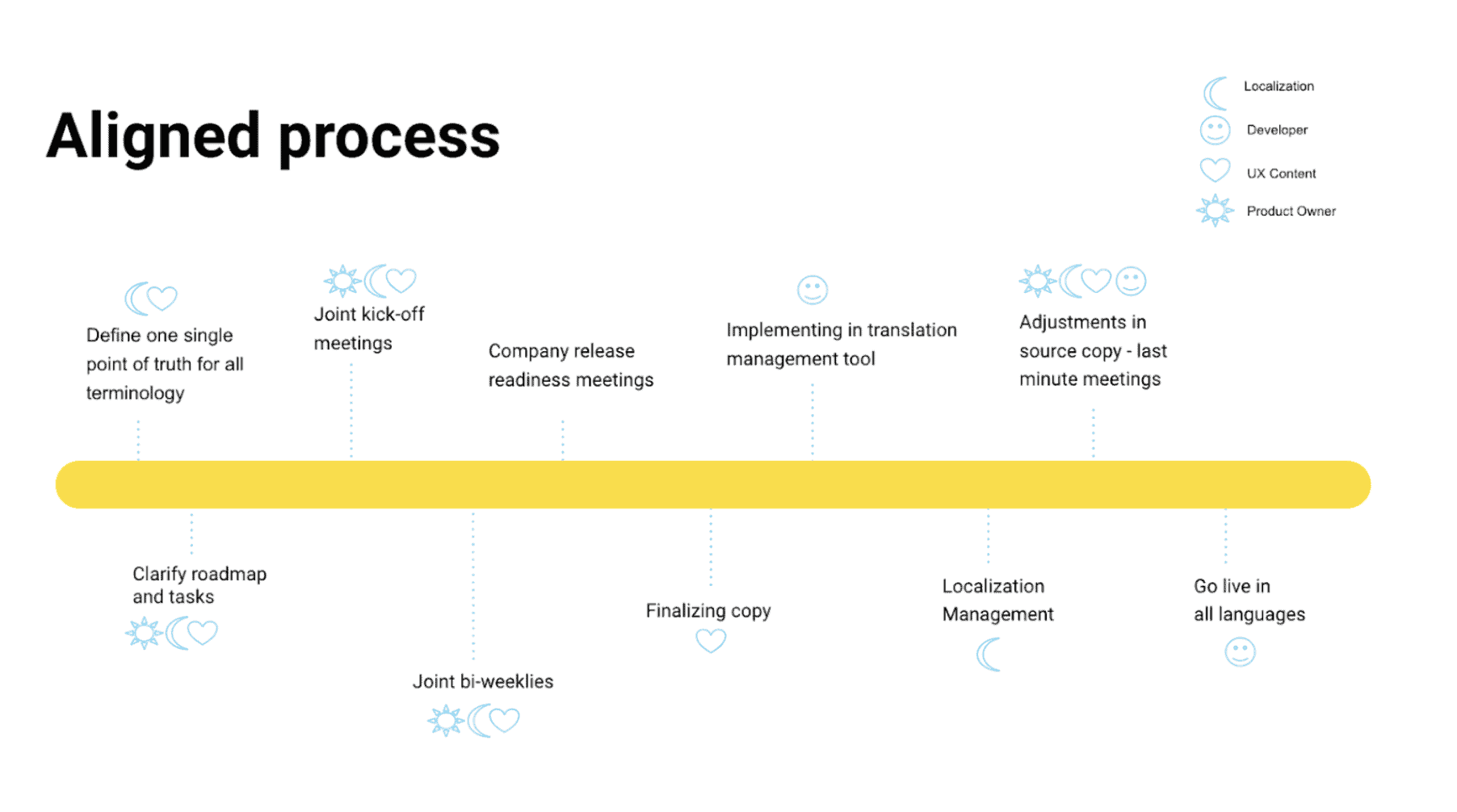

Imagine a slice of freshly baked bread, golden and crispy on the outside, soft and fluffy inside. Now, drizzle some high-quality extra virgin olive oil on top, and take a bite. The combination of bread and oil is simple yet delicious, and it has been a staple of Mediterranean cuisine for centuries. But what does it have to do with UX content and localization?
Let’s pretend bread represents UX content and oil represents localization. Together, they form an undeniable and powerful combination. When UX content and localization team up, you’ll reach a more global audience, build a better user experience, and positively grow your business.
In today’s globalized world, with businesses catering to a diverse audience worldwide, content and localization have become critical components of a brand’s success.
Localization refers to the process of adapting a product or service to suit a specific country, region, or culture. UX (User Experience) content refers to the textual, visual, and interactive elements of a product that help users achieve their goals. Both of these components work hand in hand to create a great user experience, especially for non-English speaking audiences.
While many believe that English is the primary language of the internet, the reality is far different. Of the 7,100 languages spoken worldwide, English is spoken by only a quarter of the global population. Despite this, almost 60% of all websites are in English, highlighting the significant gap between content and audience. The combined efforts of UX content and localization serve as the bridge.
The need for localization becomes even more apparent when we consider the results of a survey conducted by CSA Research in 2020, which revealed that 73% of consumers prefer products with information in their own language, while 40% will not purchase from websites in other languages. 65% of consumers prefer content in their language, even if it’s poor quality. These figures clearly indicate that localized content ensures a brand’s success in the global marketplace.
To make UX content and localization work effectively, both teams must create a collaboration framework. This means ensuring physical and structural proximity, with both teams working closely and sharing resources. Both functions attend kick-off meetings and get an understanding of the product and context on the same level.
Businesses need to ensure that localization is not an afterthought and is part of the content planning process. This means having a seat at the table during copy discussions and design meetings.
To align UX content and localization, you must establish common goals.
The first goal should be consistency in all of the content delivered, regardless of the number of languages involved. This consistency ensures that users are not confused by inconsistent wording, styles, and names.
The second goal is to have a single source of truth for the company’s/product’s language, which can be a translation memory tool, glossary, or voice and tone guidelines. Having this builds the bridge to goal number one: consistency. This is impossible to achieve without any kind of documentation.
Common goals aren’t enough if the implementation process is not there. In our case, we worked on this for about 2 years. Presence and patience are the door openers. The process outlined ensures that UX content and localization specialists are involved at every key stage of product development. Their expertise flows into the final product:

After establishing a framework and aligned processes, it’s time to think about spreading your great work. Only with the right stakeholders will your new way of working have a chance to anchor in company culture. But before that, you need to gather some short wins that will make getting allies on board easier.
One example we love to share is how we significantly drove email conversions with a simple question. For our review email product team, a subject line is the first step to reaching consumers.
If people click on an email that invites them to review a product or service, the chance is also high that they’ll hit the review button. More reviews mean better company reputation and potential sales growth.
Goal: Drive email conversions and increase the number of product reviews.
The success of these campaigns is crucial to the work of our review email product team. We jumped on this project to not only drive success for the email team but also to show the power of UX content and localization in action.
Tactic: Increase conversions with A/B testing.
We started brainstorming and creating subject lines with different behavior patterns in mind based on user demographics and geographies. The more we tested, the more we found a scheme of how these subject lines worked or didn’t. Based on our findings, we refined and reworked our ideas. The start was rough, but after some weeks we had clear a conversion winner.
We learned that this phrase: A quick question about XY resonated most with users. Why? Certainly, because it was short. But also because it was very clear, concise, and caught their attention.
The conversion of our emails increased by 20% in the first weeks and stabilized by 17%.
This wasn’t the end of the project but the very beginning. As the subject line converted great in some markets, it didn’t work as well in others. The real takeaway was that our colleagues could see the real value of our work in this isolated test. From there, we got resources to expand our efforts to other markets and campaigns.
The success of any change program depends on the ability to create urgency and build a winning coalition. Simply having a good idea is not enough to change the workflow of an organization. To make a real difference, getting more than one person on board who can help advocate for the new workflow is crucial. These allies can include people in strategically important positions, such as product owners and product management.
Creating urgency is also vital to the success of any change program. One way to do this is by demonstrating the financial benefits of the new workflow. By becoming more efficient, an organization can save money, which can then be used to further optimize and professionalize the work. Short-term wins are also important in creating urgency. By showcasing how collaboration has saved time and money, it’s possible to convince others of the value of the new workflow.
For example, embedding a localization project manager at the beginning of the process can eliminate the need for a time-consuming briefing process that often leads to confusion and delays. By creating these short-term wins and demonstrating the financial benefits of the new workflow, it’s possible to build a winning coalition that can drive real change within an organization.
After all your effort, it’s time to anchor this new way of collaborating efficiently by breaking down silos. Perhaps you even want to organize a company event where you bring UX content and localization folks together? Don’t forget to serve up some bread and olive oil. There’s no better experience to prove that one alone will never run the show.

Explore our accessibility and localization training:
Get our weekly Dash newsletter packed with links, regular updates with resources, discounts, and more.
